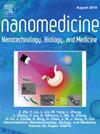低氧响应治疗纳米平台强化化疗-光热/光动力三联疗法和荧光示踪在结直肠癌消融中的应用。
IF 4.6
2区 医学
Q2 MEDICINE, RESEARCH & EXPERIMENTAL
Nanomedicine : nanotechnology, biology, and medicine
Pub Date : 2025-03-31
DOI:10.1016/j.nano.2025.102816
引用次数: 0
摘要
光热疗法(PTT)是一种新兴的癌症治疗方式,对临床患者显示出巨大的潜力。然而,传统的PTT存在肿瘤细胞耐热性的限制(如热休克蛋白,HSPs的过度表达)和对正常细胞的不良影响。为了打破这种束缚,本文设计了一种低氧反应治疗纳米平台(GA/BN LIP),通过克服热休克反应,实现协同化疗、光热治疗(PTT)和光动力治疗(PDT),同时实现荧光示踪。GA/BN LIP由低氧反应脂质体(DSPE-AZO-PEG)为外壳组成,表面功能化的cRGD肽靶向结合肿瘤中表达的整合素αVβ3受体。GA/BN LIP作为HSP90抑制剂和缺氧反应光敏剂Bcy-NO2共递送甘草酸(GA)。GA/BN LIP通过整合素αVβ3受体介导的内吞作用进入肿瘤细胞后,由于脂质体的裂解,药物在缺氧条件下特异性释放。GA不仅直接杀死肿瘤细胞实现化疗,而且通过下调HSP90蛋白表达使肿瘤细胞对PTT增敏,同时bby - no2靶向线粒体进行PTT和PDT联合治疗。有趣的是,硝基还原酶(NTR)对bby - no2的还原导致荧光恢复,实现了活细胞治疗过程的实时监测。综上所述,该治疗系统旨在针对低氧肿瘤微环境,利用致敏机制增强化疗/PTT/PDT治疗的协同作用,从而在体外和体内研究中提高抗肿瘤疗效。本文章由计算机程序翻译,如有差异,请以英文原文为准。

Hypoxia-responsive theranostic nanoplatform with intensified chemo-photothermal/photodynamic ternary therapy and fluorescence tracing in colorectal cancer ablation
Photothermal therapy (PTT) is an emerging cancer therapeutic modality displaying the great potential to clinical patients. However, the conventional PTT is suffering from restrictions of heat resistance of tumor cells (e.g. the overexpression of heat shock proteins, HSPs) and adverse effects to normal cells. To break the shackles, herein, a hypoxia-responsive theranostic nanoplatform (GA/BN LIP) was designed for achieving synergistic chemotherapy, photothermal therapy (PTT), and photodynamic therapy (PDT) through overcoming heat-shock response, while enabling fluorescence tracing. The GA/BN LIP consisted of a hypoxia-responsive liposomal material (DSPE-AZO-PEG) as the shell, surface-functionalized with cRGD peptides targeted binding to integrin αVβ3 receptor expressed in tumors. The GA/BN LIP co-delivered gambogic acid (GA) as HSP90 inhibitor and hypoxia-responsive photosensitizer Bcy-NO2. After GA/BN LIP entering tumor cells by integrin αVβ3 receptor-mediated endocytosis, drugs were specifically released in response to hypoxic conditions due to lysis of liposomes. GA not only directly killed tumor cells to realize chemotherapy, but also sensitized tumor cells to PTT by downregulating HSP90 protein expression, meantime Bcy-NO2 targeted mitochondria for combined PTT and PDT. Intriguingly, the reduction of Bcy-NO2 by nitroreductase (NTR) resulted in the restoration of fluorescence, achieving real-time monitoring of the theranostic process in live cells. In conclusion, this theranostic system, designed to target the hypoxic tumor microenvironment, utilized a sensitization mechanism to enhance the synergistic effects of chemo/PTT/PDT therapy, resulting in improved antitumor efficacy in both in vitro and in vivo studies.
求助全文
通过发布文献求助,成功后即可免费获取论文全文。
去求助
来源期刊
CiteScore
11.10
自引率
0.00%
发文量
133
审稿时长
42 days
期刊介绍:
The mission of Nanomedicine: Nanotechnology, Biology, and Medicine (Nanomedicine: NBM) is to promote the emerging interdisciplinary field of nanomedicine.
Nanomedicine: NBM is an international, peer-reviewed journal presenting novel, significant, and interdisciplinary theoretical and experimental results related to nanoscience and nanotechnology in the life and health sciences. Content includes basic, translational, and clinical research addressing diagnosis, treatment, monitoring, prediction, and prevention of diseases.

 求助内容:
求助内容: 应助结果提醒方式:
应助结果提醒方式:


